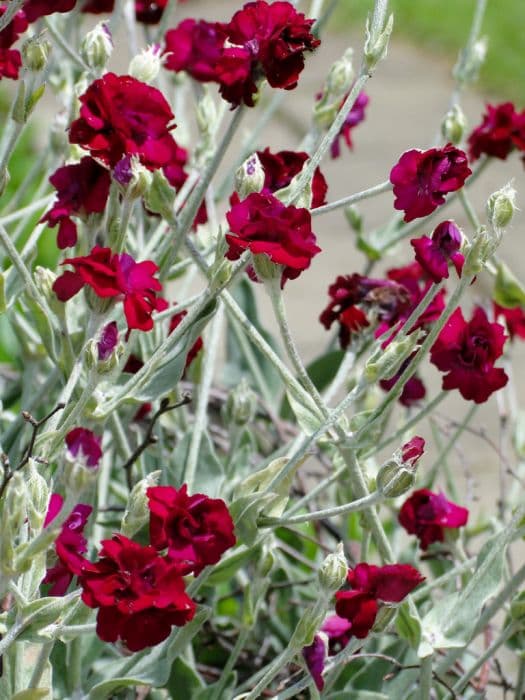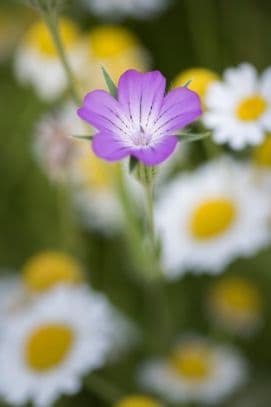Pink Dianthus Dianthus 'Spinfield Betty's Pink' (b)

ABOUT
Dianthus 'Spinfield Betty's Pink', commonly known as pink, is a charming plant with a showy display of blooms that capture attention in any garden setting. The flowers are the most striking characteristic, featuring a lovely shade of pink that is both soft and bold. Each petal has a slightly frilled edge, giving the flowers a delightful, ruffled appearance that adds to their ornamental appeal. The petals are known to exhibit a pattern that may include subtle striations or a deeper pink eye catching zone at the base, contributing to the flower's striking look. This complex pattern gives each bloom a unique identity, while still maintaining a cohesive look throughout the plant. The foliage of the pink provides a perfect backdrop for the bright flowers. The leaves are slender and elongated with a bluish-green hue, which forms a dense mound of foliage that is both neat and tidy. This foliage contrasts beautifully with the pink blossoms, making their color pop even more. Pinks typically have a compact and mounded growth habit, which helps to create a full and lush appearance. The combination of the beautiful pink flowers and the bluish-green foliage creates a picturesque contrast that is visually striking in garden landscapes. Overall, the Dianthus 'Spinfield Betty's Pink' is admired for its vibrant blooms and neat foliage, which together make it a popular choice for those looking to add some pink charm to their garden palette.
About this plant
 Names
NamesFamily
Caryophyllaceae.
Synonyms
Betty's Pink Dianthus, Pink Dianthus, Cheddar Pink.
Common names
Dianthus 'Spinfield Betty's Pink'
 Toxicity
ToxicityTo humans
The Dianthus 'Spinfield Betty's Pink', more commonly known as Carnation, is not considered toxic to humans. However, ingestion of any part of the plant can cause mild gastrointestinal discomfort, including nausea and vomiting, in sensitive individuals or if consumed in large quantities.
To pets
Carnations are considered to be mildly toxic to pets. If ingested, it can cause symptoms such as gastrointestinal upset, which may include vomiting, diarrhea, and loss of appetite. While not life-threatening, it is advisable to keep Carnations out of reach of pets and to consult a veterinarian if any significant amount is ingested.
 Characteristics
CharacteristicsLife cycle
Perennials
Foliage type
Evergreen
Color of leaves
Green
Flower color
Pink
Height
1 foot (30 cm)
Spread
1 foot (30 cm)
Plant type
Herb
Hardiness zones
Varies
Native area
Europe
Benefits
 General Benefits
General Benefits- Aesthetic Appeal: Dianthus 'Spinfield Betty's Pink', commonly known as Carnation, offers vibrant pink flowers that enhance the beauty of gardens and landscapes.
- Fragrance: The Carnation is well known for its pleasant, spicy fragrance that can add a delightful scent to outdoor spaces or when used as a cut flower indoors.
- Long Blooming Period: Carnations typically have a lengthy blooming season, providing enduring color and interest in the garden.
- Attracts Pollinators: This plant can attract bees and butterflies, contributing to the health and productivity of the garden ecosystem.
- Low Maintenance: Carnations are known for being low-maintenance plants, which is ideal for gardeners looking for easy-care options.
- Drought Resistance: Carnations are relatively drought-resistant once established, making them suitable for gardens in drier climates or for water-wise landscaping.
- Cut Flower Use: The sturdy stems and long-lasting flowers of Carnations make them perfect for use in floral arrangements and bouquets.
- Versatility in Landscaping: Carnations can be used in various garden settings, such as borders, rock gardens, and containers.
 Medical Properties
Medical PropertiesThis plant is not used for medical purposes.
 Air-purifying Qualities
Air-purifying QualitiesThis plant is not specifically known for air purifying qualities.
 Other Uses
Other Uses- Carnation 'Spinfield Betty's Pink' petals can be crystallized and used as edible decorations for cakes and desserts, adding a touch of elegance and a mild spicy flavor.
- The blooms of Carnation 'Spinfield Betty's Pink' can be pressed and included in personal stationery designs or bookmarks, adding a botanical flair to paper goods.
- Dried Carnation 'Spinfield Betty's Pink' flowers can be incorporated into potpourri mixes, providing a gentle fragrance to a room when combined with other herbs and spices.
- Carnation 'Spinfield Betty's Pink' can serve as a natural dye source for fabrics, yielding shades of light pink or beige depending on the mordant used.
- Whole Carnation 'Spinfield Betty's Pink' flowers can be floated in bowls of water as a decorative and fragrant centerpiece for special events or intimate dinners.
- The long-lasting flowers of Carnation 'Spinfield Betty's Pink' can be used for floral jewelry such as corsages and boutonnieres, making them popular for proms and weddings.
- Carnation 'Spinfield Betty's Pink' can be used in crafting homemade soaps, providing a natural colorant and a delicate fragrance to the finished product.
- The blooms of Carnation 'Spinfield Betty's Pink' are sometimes used in aromatherapy for their soothing and relaxing scent, especially when dried and used in sachets.
- Fresh Carnation 'Spinfield Betty's Pink' flowers can be used to create a natural and aesthetically pleasing insect repellent, deterring pests by interplanting them with vegetable crops.
- Petals of the Carnation 'Spinfield Betty's Pink' can be used in creating floral waters or perfumes, giving a subtle scent that can be used as a personal fragrance or linen spray.
Interesting Facts
 Feng Shui
Feng ShuiThe Dianthus, commonly known as Carnation, can be used in Feng Shui to attract positive energy, enhance love and marriage luck, and bring the blessings of joy and protection. Place pink carnations in the southwest area of your home or garden to strengthen relationships and encourage love.
 Zodiac Sign Compitability
Zodiac Sign CompitabilityCarnations are not used in astrology practice.
 Plant Symbolism
Plant Symbolism- Love: Dianthus, commonly known as "Pinks," often symbolizes love and affection due to their attractive and bright flowers.
- Admiration: The vibrant hues and pleasant scent of Dianthus flowers can represent admiration and high esteem one person might hold for another.
- Pure Affection: "Pinks" are traditionally associated with a pure and platonic form of affection, making them suitable for gifts when romantic connotations are not intended.
- Boldness: Due to their striking appearance, Dianthus flowers can also come to symbolize boldness or daring.
- Divine Love: In Christian symbolism, the Dianthus flower is sometimes associated with divine love, signifying the eternal love of God.
 Water
WaterCarnations need to be watered regularly to keep the soil moist but not soggy, ensuring proper drainage to prevent root rot. During the growing season, watering once a week with approximately one gallon of water per plant is recommended. In hotter weather, check the moisture level more frequently, as the soil can dry out faster, and be prepared to water twice a week if necessary. Reduce watering in the winter months when the plant is not actively growing. Always check the top inch of the soil for dryness before watering to avoid overwatering.
 Light
LightCarnations thrive in full sun, receiving at least 6 to 8 hours of direct sunlight daily. Plant them in a spot where they will receive ample morning light, which is less harsh, while still benefiting from the afternoon sun. Avoid locations with prolonged shade as this can lead to poor flowering and an increased risk of disease.
 Temperature
TemperatureCarnations prefer a temperature range of 60-70 degrees Fahrenheit during the day and cooler temperatures around 50-60 degrees Fahrenheit at night. They can tolerate temperatures as low as 40 degrees Fahrenheit and as high as 80 degrees Fahrenheit. Ideal growing conditions fall within this range to promote healthy growth and flowering.
 Pruning
PruningRegular pruning encourages carnations to produce more blooms and maintain a compact form. Deadhead spent flowers to stimulate new growth. In late winter or early spring, prune back the stems to about 6 inches from the ground to promote healthy, vigorous stems. Pruning should be done at least once a year or as required to keep the plant tidy and free from dead or diseased growth.
 Cleaning
CleaningAs needed
 Soil
SoilCarnations, such as 'Spinfield Betty's Pink', prefer a well-draining soil mix with some organic matter, like a combination of loamy soil, compost, and sharp sand. The ideal soil pH for carnations is slightly alkaline, around 7.0 to 7.5. Regular feeding with a balanced fertilizer will support their vibrant blooms.
 Repotting
RepottingCarnations do not need frequent repotting; 'Spinfield Betty's Pink' should be repotted once every 2-3 years or when it is visibly root-bound. Ensure to use fresh soil mix matching their preferred pH and drainage characteristics during repotting.
 Humidity & Misting
Humidity & Misting'Spinfield Betty's Pink' Carnations prefer moderate humidity levels but are adaptable to a range of conditions. They can tolerate some dry air but should not be in overly humid environments, which can encourage fungal diseases.
 Suitable locations
Suitable locationsIndoor
Place in bright light and ensure good air circulation.
Outdoor
Plant in full sun and protect from extreme cold.
Hardiness zone
3-9 USDA
 Life cycle
Life cycleDianthus 'Spinfield Betty's Pink', commonly known as Dianthus or Pink, begins its life cycle as a seed, which, when sown in well-drained soil and given the proper conditions, will germinate and sprout. The seedling stage follows, where the young Pink establishes roots and shoots, forming a rosette of foliage close to the ground. As it matures into its vegetative stage, the plant develops a sturdy stem and fuller foliage, preparing for the next stage of flowering. During the reproductive stage, typically in late spring to early summer, the Dianthus produces vibrant pink blossoms atop slender stalks, which attract pollinators for seed production. After pollination, the plant sets seed which can be collected and dispersed to produce new plants. Finally, as an herbaceous perennial, the Dianthus may die back to the ground in winter but will regrow from its base in the following growing season.
 Propogation
PropogationPropogation time
Spring-early summer
Dianthus 'Spinfield Betty's Pink', also known as "pinks", is most commonly propagated through cuttings. This method is popular as it helps maintain the characteristics of the parent plant. The best time for taking cuttings for propagation is late spring to early summer when the plant is actively growing. Select a healthy, non-flowering stem and cut a piece about 3 to 5 inches (8 to 13 cm) long just below a leaf node. Strip the lower leaves off and dip the cut end into a rooting hormone powder to encourage root development. The cutting should then be inserted into a mix of perlite and peat moss and kept moist but not waterlogged. Covering the cutting with a plastic bag can help maintain humidity levels and improve the chances of rooting. It generally takes 2 to 4 weeks for roots to develop, after which the new plant can be transferred to a pot or the garden.








